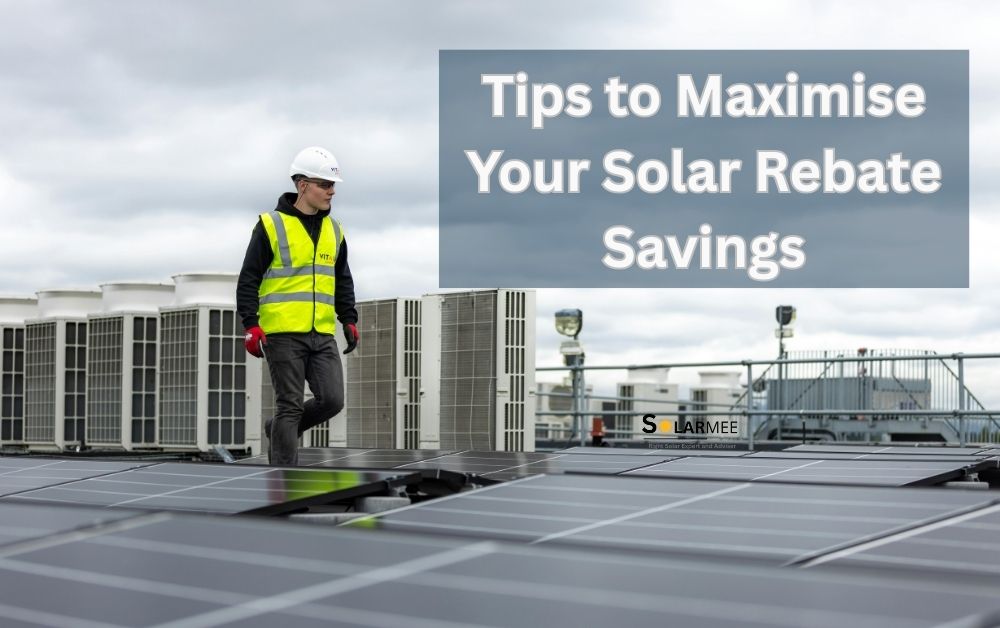The need for solar energy in Australia has never been higher, with the cost of power on the increase and more than 4 million households and companies already producing their own electricity. The solar panel rebate schemes in Australia have made the conversion to solar more affordable, resulting in thousands of dollars saved on upfront installation costs for both residential and business users.
These rebates directly affect solar and battery systems, reducing their cost and increasing adoption and energy self-reliance. This blog will give you a full how-to guide to solar panel rebates: a clear explanation, application tips to save more, and updated reviews.
Regardless of whether you are a homeowner or business owner, it might be quicker to pay back and reduce your energy expenses by knowing and claiming rebates. Find out the reasons why the solar panel rebate in Australia is important, and the ways you may optimise your gains by getting the best tips and ideas.
Solar Panel Rebates in Australia
A government incentive in Australia is a solar panel rebate, reducing the cost initially for solar panel installations in businesses, along with homes. The Small-scale Renewable Energy Scheme (SRES) is offering the federal rebates that are available. Each eligible system receives Small-scale Technology Certificates (STCs) under this scheme.
These STCs are by way of tradable credits or automatic discounts; they simply cut the cost of installing the solar panels—this is the major government rebate for solar panels.
The rebates at the state level differ depending on the region and might also have other cash incentives, interest-free loans, or battery rebates. There are programs in some states that are specifically focused on low-income households and renters. The Australian solar panel rebate program is not a means-tested one and is available to any eligible installation.
The claim criteria require that systems should be of a specific size (typically up to 100 kW) and installed by accredited professionals who are accredited by the Clean Energy Council. This arrangement accelerates the payback process and allows accessibility of clean energy to all.
Also Read: What is a Solar Panel Rebate?
Who is Eligible for a Solar Rebate?
The eligibility of solar panel rebate in Australia is applicable both to households and to businesses, with its own requirements. Any homeowner, landlord (with permission), or other small business owner can apply, as long as the property is in a qualifying location.
Residential applications are required to either own the property; renters must have the approval of the landlord. To qualify based on commercial rebates, small to medium businesses can qualify, provided that the solar or battery system helps them in their operation.
All the systems should be installed by accredited professionals by the Clean Energy Council, and the size of the system matters, which is usually less than 100 kW in a home setting and up to 100 kWh battery capacity in business premises. There are state programs that incorporate income caps on residential rebates. Important hint: It is necessary to own property and hire certified installers.
To ensure the eligibility of the person receiving the solar rebate is checked regularly, the eligibility of the solar panel rebate should be reviewed before installation to avoid hitches during eligibility.

How to Apply for a Solar Panel Rebate in Australia
| Step | Action | Details |
| Step 1 | Choose an approved installer | To be eligible for rebates, select a Clean Energy Council (CEC)-accredited solar installer. |
| Step 2 | Ensure system compliance | Confirm your solar system meets CEC standards for products and installation requirements. |
| Step 3 | Submit application | Apply through your installer who claims the rebate, or submit a direct claim via government portals. |
Benefits of Solar Rebates
Solar rebates also lower the initial cost of installing solar panels to a large margin because solar energy becomes more affordable to homeowners and businesses. Rebates also reduce the cost of installation, thus minimizing the payback period, such that users recover their investment in a short time frame. This financial encouragement shall spur wider renewable energy use.
Therefore, sustainability is improved, and environmental effects are lessened. Over time, solar energy users have lower electricity bills. This is on account of the energy coming from the sun, which is both cheaper and cleaner. Feed-in tariffs are something that is used for combining them with solar rebates when that excess energy gets fed into the grid.
This synergy returns more money with speed for the transition to renewable energy. Economic and environmental objectives get support from the synergy.
Solar Panel Rebate Programs Across States
Low-income households are prioritized in New South Wales (NSW) with schemes such as the Energy Saver Scheme, giving them financial aid to pay a lower initial price for installing solar.
The Solar Homes Program in Victoria offers a high rebate of up to $1400 on solar panel installations and other support towards battery installations, such as interest-free loans, which is one of the most comprehensive schemes.
Queensland now offers federal rebates, but also interest-free loans and periodic incentives that are dependent on the subject homeowners. South Australia attracts attention to battery rebates and subsidies instead of direct rebates for solar panels, which promotes energy storage and sustainability projects.
Other states, such as Western Australia (WA) and Tasmania, offer slightly less direct rebates on solar panels but encourage feed-in tariffs that compensate for excess energy that is sold to the grid to sustain the constant savings.
Eligibility usually depends upon property ownership, income levels, also system size, although programs are very diverse. Federal incentives combined with state ones increase the advantages of solarizing businesses and households since it is cheaper.
In order to have a comprehension of the requirements and also the most effective solar panel rebate program for your particular area, these differences are important.

Tips to Maximise Your Solar Rebate Savings
The first step in ensuring that you have optimised your savings through the solar rebate is to compare the multiple installers and quotes prior to committing. Various prices and rebate handling could be provided by different providers, and it is better to go out shopping to find the most appropriate price. Install a bigger solar system up to the limits of eligibility to earn a bigger rebate, as well as generate Solar energy.
Greater power output is assured through the choice of high-efficiency solar panels, which will guarantee a higher payback in the long term. Keep up to date on the change of government policy, as the value of rebates and incentives can change. To ensure your solar system is efficient and may also be eligible to receive any rebate benefits, properly maintain your solar system.
By putting these tips together, you will be able to have maximum benefits out of your solar panel installation rebate, and you will be contributing towards the sustainability of energy use.
Common Myths About Solar Rebates
There are myths about solar rebates. Among the myths, one is that the rebates are 100 percent of the cost to install a product; the truth is that rebates only cut the initial installations by about one-fifth, and this is usually about 2030.
The next myth is that solar rebates are about to expire, whereas the values of the rebates are slowly diminishing, and the programs will be discontinued by 2030. However, significant incentives will still be available in 2025 to encourage the implementation of solar.
There is also a belief that only homeowners can apply; many cases offer the rebates to small businesses, and under some circumstances, even the landlord supports the renters. Requirements for eligibility are to be reviewed together with details of the program. Adjustments are made by staff regularly for them.
About solar energy investments, this knowledge allows homeowners and businesses to choose wisely in order to gain maximum savings.
Also Read: Solar Power Government Rebate Sydney
Conclusion
Solar rebates lower the initial costs by quite a margin. Therefore, solar panels are more affordable to install in Australian homes as well as businesses. These subsidies allow for speeding up the process of switching to clean energy, in addition to long-term financial benefits in terms of electricity payments.
One must ensure that he/she verify eligibility requirements and apply in time to get the best available rebates before the money runs out or the value goes down. To receive individualized guidance and an easy rebate procedure, call an experienced solar installer who can assist in selecting the appropriate system and also claim your rebate easily. This move will be sustainable, yet cost-effective.

I am Vanshika, a passionate writer, digital marketer, and explorer of ideas. With expertise in SEO, social media, content creation, and website design, I combine creativity with strategy to deliver impactful digital solutions. Writing is my way of sharing knowledge, sparking curiosity, and building meaningful connections with readers. Through my blog Vanshi’s Exploration, I share unique insights on finance, travel, technology, and future-forward thoughts that inspire and inform.




